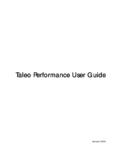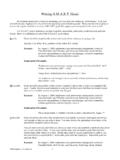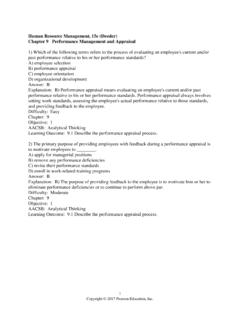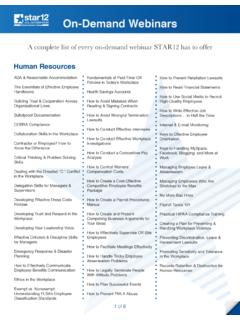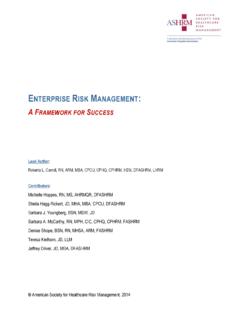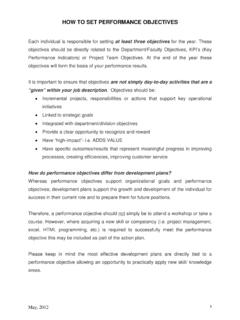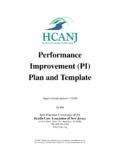Transcription of About the Training Program Training Objectives
1 Boise State University - 1 April 24, 2007 performance management creating smart Objectives : Participant Guide Program OVERVIEW About the Training Program This session is designed to enable participants to learn and apply concepts and techniques to develop realistic and achievable expectations for your employees. Each employee plays an important role in making Boise State University the best it can be. Effective performance management gives us tools to bring out the best in employees and allows Boise State University to achieve its goals. The focus today is on establishing smart Objectives , developing and motivating employees by ensuring their activities are linked to the overall goals and mission of BOISE STATE UNIVERSITY. Training Objectives Participants will have the following opportunities to: Discuss the difference between Goals and Objectives ; Establish smart Objectives for employees; and Discuss tools to keep performance on target (managing to smart Objectives ).
2 Specific Measurable Achievable Relevant Timely Boise State University - 2 April 24, 2007 performance management Process Overview Elements of the performance management Process Leadership Means .. Establishing an environment conducive to excellence. Managing for performance Taking all opportunities to support individual and organizational achievement and growth. Communicating Expectations clearly and concisely Holding employees accountable Boise State University - 3 April 24, 2007 Setting smart Objectives Setting Job Goals and Objectives performance goals and Objectives are written to describe the measurable results an employee needs to achieve within each key responsibility area. performance goals and Objectives should be tied to the strategic mission and goals of Boise State University.
3 Goals and Objectives tend to be used interchangeably. To differentiate between the two remember this: "The goal is where we want to be. The Objectives are the steps needed to get there." Objectives are meant to be realistic targets for a Program or project. Objectives are written in an active tense and use strong verbs like plan, write, conduct, produce, etc., rather than learn, understand, feel. Objectives can help you focus your Program on what matters. It always answers the question Who is going to do What, When, Why (what does it demonstrate), and to What Standard? Setting Goals and Objectives Setting Objectives creates employee motivation and should help the employee connect the job to the mission of Boise State University. Objectives clarify the performance expectations within each key responsibility area (from job descriptions) and describe how they will be met and measured.
4 Objectives provide guidance for the employee and help keep performance focused throughout the evaluation period. When Objectives are discussed and written, the supervisor and the employee have a thorough understanding of what performance is expected. Types of Objectives There are three main types of Objectives that may be used in developing a Program or project plan: process, impact, and outcome. Process Objectives : help you be more accountable by setting specific numbers/types of activities to be completed by specific dates. Process Objectives tell what you are doing and how you will do it. They describe participants, interactions, and activities. Impact Objectives : tell how you will change attitudes, knowledge or behavior in the short term and describe the degree to which you expect this change.
5 Outcome Objectives : tell what the long-term implications of your Program will be by describing the expected outcome for the community. (Outcome Objectives are rarely measurable because many different elements may influence what is being measured.) Boise State University - 4 April 24, 2007 Three components to create a clear objective: 1. performance - what the employee is expected to do (goal). Steps or measurements needed to meet or clarify goal: 2. Criteria - the quality or level of performance that will be considered acceptable, often described in terms of speed, accuracy and/or quality (time frames). 3. Conditions - conditions under which the performance is expected to occur. An example of a clearly written job objective incorporating these components could be written as follows: The employee will write reports for the department at the end of each week while the legislature is in session.
6 1. performance : The first component, performance , helps communicate what the employee is expected to perform. The performance is usually written using a verb that describes the action of the performance . Using the example from above, the performance of this objective is highlighted below. The employee will write reports for the department at the end of each week while the legislature is in session. 2. Criteria and Quality The second component, criteria, describes the quality, level, and timeliness standards by which the performance should be accomplished. The criteria of the example job objective are highlighted below. The employee will write reports for the department at the end of each week while the legislature is in session. The preceding example described criteria in terms of timeliness.
7 Another way to describe the criteria for a performance objective is to use accuracy measures. This can be expressed using a percentage. For example: The employee will write reports for the department with zero grammatical errors while the legislature is in session. Quality of performance is another critical criterion. Sometimes quality, timeliness, and accuracy are important. All characteristics may be addressed in the objective. 3. Condition: The third component, condition, describes the situation, timeframes, and the environment specifics in which the performance is to occur. The conditions of the example job objective are highlighted below. Boise State University - 5 April 24, 2007 The employee will write reports for the department at the end of each week while the legislature is in session.
8 Objectives may be one or several sentences in length. Several sentences may be required to communicate the intent clearly. To ensure success, make the performance evaluation a living document. Take it out at least quarterly and review with the employee the job goals and Objectives and consider the following: Prioritize goals and Objectives . Build flexibility into goals and Objectives to ensure adaptability as changes occur in the job or department. Ask About obstacles and take action to eliminate them. Setting smart Objectives : smart Objectives refers to an acronym built around the key characteristics of meaningful Objectives , which can be very helpful in writing Objectives that can be employed to evaluate the quality of programs proposed and carried out. 1.
9 Specific Objectives should specify what they want to achieve. (concrete, detailed, well defined). 2. Measurable You should be able to measure whether you are meeting the Objectives or not. (numbers, quantity, comparison) 3. Achievable - Are the Objectives you set, achievable and attainable? 4. Realistic Can you realistically achieve the Objectives with the resources you have? 5. Time When do you want to achieve the set Objectives ? Let s look at these characteristics in more detail: Specific What exactly are we going to do, with or for whom? Specific means that the objective is concrete, detailed, focused and well defined. The Program states a specific outcome, or a precise objective to be accomplished. The outcome is stated in numbers, percentages, frequency, reach, scientific outcome, etc.
10 To help set specific Objectives it helps to ask: WHAT am I going to do? These are best written using strong, action verbs such as conduct, develop, build, plan, execute, etc. This helps your objective to be action-orientated and focuses on what s most important. WHY is this important for me to do? WHO is going to do what? Who else needs to be involved? WHEN do I want this to be completed? HOW am I going to do this? Boise State University - 6 April 24, 2007 Diagnostic Questions What exactly are we going to do, with or for whom? What strategies will be used? Is the objective well understood? Is the objective described with action verbs? Is it clear who is involved? Is it clear where this will happen? Is it clear what needs to happen? Is the outcome clear?
